The Waiting Game
RSM’s 2011 annual oxygen market analysis shows providers in a holding pattern.
- By Joseph Duffy
- Jun 01, 2011
RSM’s last oxygen market analysis survey, administered to members of an industry besieged by ongoing cuts, caps and the impending implementation of Round One of competitive bidding, revealed pronounced uncertainty pervading a market in flux.
With the first round of competitive bidding making its Jan.1, 2011 appearance in Charlotte, Cincinnati, Cleveland, Dallas-Fort Worth, Kansas City, Miami, Orlando, Pittsburgh, and Riverside, California, our current survey reveals that we may still be in a holding pattern, and that the storm that respondents predicted has either slowed or providers are adapting with some successes. There are also pockets of frustration for respondents who lost business over the last 12 months and struggle to figure out why.
Here are some 2011 survey highlights:
- 63.4 percent of respondents said their business grew over the last 12 months, compared to 60.4 percent in 2010.
- 40.4 percent called the 36-month oxygen cap the greatest challenge for their business, where 54.2 percent blamed the cap in 2010.
- 57 percent said they are not considering exiting the oxygen business due to caps and cuts, where 66.9 percent considered exiting last year.
OUR RESPONDENTS
Typical 2011 RSM Oxygen Market Analysis survey-takers were consistent with last year’s demographic. Their primary jobs are: Respiratory HMB business owners (46.3 percent), respiratory services managers (34.7 percent), respiratory therapists at a homecare company (15.8 percent) and respiratory therapists at a hospital (3.2 percent). In 2010, the percentages were slightly different but the primary job order was the same.
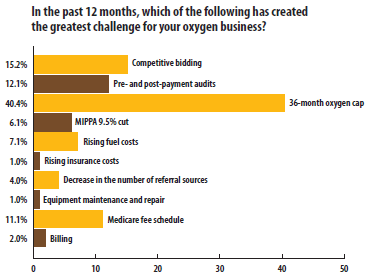
The client base of a high percentage of respondents has COPD. A little over 40 percent of respondents said COPD makes up 51 percent to 75 percent of their client base, while 24 percent said more than 76 percent of their clients have COPD.
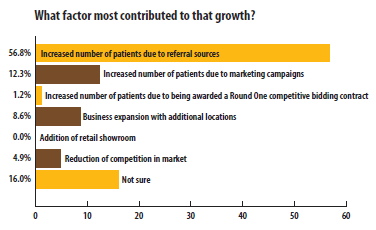
According to the 2011 oxygen survey, respondents’ business model for oxygen delivery has changed slightly. In 2010, a mixture of equipment options with emphasis on oxygen cylinder delivery led the pack with 31.2 percent of respondents saying it best described their oxygen delivery model. In 2011, survey takers described the model as:
- 34.5 percent said stationary concentrators and oxygen cylinder delivery only
- 29.1 percent said a mixture of equipment options with emphasis on oxygen cylinder delivery
- 23.6 percent said a mixture of equipment options with emphasis on transfilling systems and/or POCs
Respondents who said they have a program to service traveling oxygen patients was 64.6 percent, with 23.9 percent saying they didn’t have a program and 11.5 percent contracting POC rentals.
One respondent commented, “Where to start ... still having issues with the two years of only billing for contents but having to service my clients 24/7. Trying to keep up with companies that can afford the portable concentrators for their clients. The Internet companies are killing us. Everyone can buy anything off of the net now and I cannot compete with those prices. After 23 years of DME business, [I am] ready to throw it all in. Us small companies will all lose soon.”
Of those respondents (63.4 percent) reporting growth of their oxygen business, 36.4 percent said their business grew 6 percent to 10 percent in the last 12 months, while 26 percent reported less than 5 percent growth. What factors lead to growth? Respondents overwhelmingly pointed to an increased number of patients due to referral sources (56.8 percent). Interestingly, 16 percent of those respondents experiencing growth said they were not sure of the factors that most contributed to their growth. Behind that at 12.3 percent, respondents said growth was a result of an increased number of patients due to marketing campaigns.
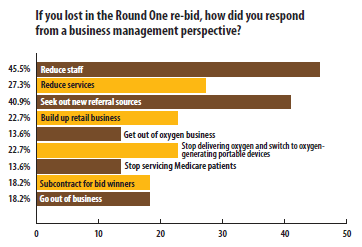
Of those respondents who said their business contracted over the last 12 months, the most popular reason (35 percent) was not sure. Close behind was decreasing Medicare funding due to rental cap or other developments with Medicare funding (30 percent).
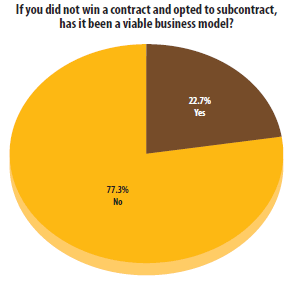
INDUSTRY CHALLENGES
In an industry with its fair share of challenges, oxygen providers once again named the 36-month oxygen cap (40.4 percent) as its greatest challenge for their business. Trailing that at 15.2 percent is competitive bidding, which will be interesting to watch as it starts rolling out to other CBAs. Other challenges include:
- Pre- and post-payment audits (12.1 percent)
- Medicare fee schedule (11.1 percent)
- Rising fuel costs (7.1 percent)
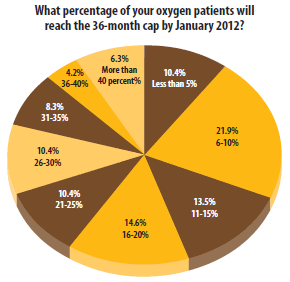
Challenges caused by the 36-month cap that respondents are experiencing include delivering equipment/oxygen cylinders (32.3 percent), maintaining customer service (24.7 percent), providing oxygen for traveling/relocating patients (14 percent), servicing and repairing equipment (11.8 percent), maintaining respiratory therapist service (10.8 percent) and negotiating pricing for oxygen for traveling/relocating patients (6.5 percent). In 2010, respondents said delivering equipment and oxygen cylinders was third on the list at 15.3 percent. In 2011, we see it spike to 32.3 percent as the No. 1 challenge due to the cap.
WHO ARE YOUR PATIENTS?
According to 82.1 percent of survey takers, the primary diagnosis of oxygen patients is COPD. This figure is comparable to 2010’s 86.5 percent. For patients who don’t have COPD but use oxygen, the most common diagnoses are:
- Congestive heart failure (45 percent)
- Sleep apnea (21.6 percent)
- Pulmonary hypertension (9.9 percent)
- Chronic severe asthma (5.4 percent)
Similar to last year, respondents say overwhelmingly that their COPD patients want access to portable oxygen technology (75 percent in 2011, compared to 75.9 percent in 2010). Following portable oxygen, patients want more comfortable technology (11 percent). When given a choice, respondents said their patients prefer portable oxygen concentrators (52.3 percent). This is a sharp rise from 2010’s figure of 39.5 percent, showing that patients are most likely getting better educated about newer technologies.
When it comes to oxygen devices that respondents deem are easiest for their patients to use, the leader is stationary concentrators (50.5 percent), followed by portable oxygen concentrators (35.5 percent).
Provider Feedback
In addition to providing solid quantitative responses to this year’s annual Respiratory & Sleep Management survey, oxygen providers also offered up a wealth of qualitative answers. Here are some compelling comments provider’s made when answering:
What factors have contributed to your growth?
“Hospital expansion.”
“Addition of new patients with dx requiring oxygen continuous and/or intermittent based on oxygen saturations.”
“Aging population.”
What factors have contributed to your growth?
“We choose to avoid respiratory due to the high cost and low reimbursement.”
“Our patients come with oxygen already in place.”
In the past 12 months, which of the following has created the greatest challenge for your oxygen business?
“Hospitals being contracted with DME companies.”
“Doctors not wanting to fill out paperwork correctly/timely.”
“MIPPA; fuel; insurance; fee schedule.”
What additional comments do you have about the oxygen market?
“Patient load is very low due to loss of patients and referral sources due to Hurricane Katrina. We haven’t been able to recover. But the cap and the accreditation costs have been the final blow. We will probably close at end of year. Accreditation is a farce.”
“We are still having issues with the two years of billing only for contents but having to service my clients 24/7. We are trying to keep up with companies that can afford the portable concentrators for their clients. The Internet companies are killing us; everyone can buy anything off of the ’Net now, and i cannot compete with those prices! After 23 years of DME business I am ready to throw it all in. We small companies will all lose soon!”
“I am appalled how any human being with half a brain can consider cutting O2 again to 13 months. In rural areas, many small companies have already closed up. It is hard to access patients in a timely fashion, and also if they get portables with the gas prices going through the roof. Larger companies will back out of doing O2 too. Patients will then be admitted to the hospitals and then the cost of unnecessary preventable hospital stays will fall on Medicare to pay out in Part A. Stupid is as stupid does!”
“We have not found a dependable conserving device, yet!”
“Many official sources and manufacturers recommend deliveryless models for the DME industry. But with the high cost of these systems, the low warranty time frame for POCs, an uncertain future MCR fee schedule and capped rental time period, plus the RUL, such a delivery model does not seem realistic. We need better advice from our industry experts. The way I see it MCR is destroying the DME industry as it stands today. Thousands of us will be gone in the very near future. It is time to put our capital and labor into an endeavor that promises better returns. And continuing “as is” or with minor tweaks won’t cover it.”
This article originally appeared in the Respiratory & Sleep Management June 2011 issue of HME Business.